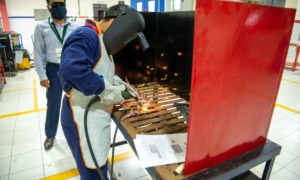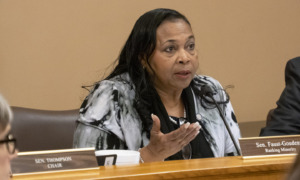Video shot by Paul Joseph Brown
(Part 1 of 2)
What many consider routine and the direct path to college can be a quagmire for traumatized youth in foster care.
It’s likely that only 50 percent of such youth complete high school by age 18, according to a summary of foster-care education research published by the National Working Group on Foster Care and Education. That compares to 84 percent of all high school youth in 2015-16, according to the latest available statistics.
And the “you must go to college to succeed in life” precept obscures the path of apprenticeships in the trades after high school. Youth in foster care can qualify for some public aid for traditional college, but what about those who are natural-born tradespeople who want to work with their hands: the electrician, carpenter, chef, mechanic?
Public money can pay for books for youth in foster care. Why can’t it pay for hammers?
It can now in the state of Washington.
On July 1, the Passport to Careers program became law. It includes two pathways: the Passport to College and the Passport to Apprenticeship Opportunities. It adds an apprenticeship path to the state’s 11-year-old Passport to College Promise Scholarship program for homeless youth and youth.
The legislation, which includes apprenticeship dollars, is the first of its kind in the nation, said Washington state Sen. Kevin Ranker. He is the chair of the Higher Education & Workforce Development Committee and one of the main sponsors of the new law.

University of Washington
Angelique Day
Angelique Day, a national expert on youth in foster care and an assistant professor of social work at the University of Washington, said she doesn’t know of any legislation like Senate Bill 6274 in the rest of the country.
‘Levels the playing field’
Youth in care who are 16 and have been in care for at least a year are eligible for the Passport to Apprenticeship Opportunities program. The legislation’s intent is to fund the mandate sufficiently in Years Two, Three and Four so youth can eventually get aid toward apprenticeship programs when they are 13.
The amount of the scholarship for each applicant is still to be determined.

Photo by Paul Joseph Brown
Shaunessy Jones
“Any time we give a kid an opportunity to pursue training they are going to go after it,” said Shaunessy Jones, an associate director in community engagement for Treehouse, a 30-year-old nonprofit in Seattle that serves youth in foster care. “That’s what I like about this program. It levels the playing field for all kids, so you don’t have to choose one path.
“We need people in the trades. We have a lot of kids in our program that want to do that sort of thing, work for Boeing, or work at a bakery, or become a dental assistant. And those are things you don’t have to go to four-year college for.”
Here is another vital detail of the legislation: It extends financial assistance to any eligible applicant for a maximum of six years or until the applicant turns 26.
The Washington Student Achievement Council (WSAC), which will help implement the legislation, is partnering with the Employment Security Department and Apprenticeship & Training Council to identify trade groups for homeless and foster youth to work with.
The trades as career paths are not only important for the youth themselves, but for society. They can bolster the aging workforce and provide skilled labor to rebuild infrastructure.
“This legislation is the kind of apprenticeship and trade program that could be built into our infrastructure needs,” Day said. “We can train our at-risk youth for work in the transportation industry and utilize a similar model for home builders, roads, bus systems and airplanes.
“I worked in Congress last year and we found that the average age of persons who worked in those fields was 45 years old. We don’t have that apprenticeship path or trade school path for young people, which is scary. If we ever get the national infrastructure discussion going forward this is going to be important.”
Infrastructure work is already booming in Seattle. Consulting firm Rider Levett Bucknall said Seattle has more cranes operating than any other city, for the third straight year.
Apprenticeships are the “earn-and-learn” path to a livelihood. Making a living and being self-reliant is the ultimate goal — both of those who work with youth in foster care for them and the foster youth themselves. The Department of Labor says the average starting wage for credentialed apprentices is more than $60,000 per year. That comes without the burden of paying back a college student loan.
Only one out of every two foster kids who age out will have solid jobs by 24 years old. More than 23,000 young people will age out of the U.S. foster care system every year, according to the National Foster Youth Institute.
The Washington state legislation feeds into the national push for workforce development. Some colleges and universities in the state already offer apprenticeship or vocational programs, the WSAC said. This goes a step further for youth in foster care by paying for their tools and other gear associated with the apprenticeship at schools.
LINING UP FOR TRAINING
Skyler Grandchamp, 21, is in Treehouse’s Graduation Success program. He has wanted to be a chef since he was 15. College was not on his radar. His dream is to have a two-story business with a café upstairs and a bakery downstairs.
“I think it is going to be very beneficial to a lot of kids who need financial support,” Grandchamp said of the legislation. “I didn’t try to go to college [after high school] and that’s another reason the program is going to be beneficial for kids who don’t think college is going to be the route they want to go. They want to jump straight into something and be hands on.”

Photo by Paul Joseph Brown
College was never on Skyler Grandchamp’s radar.
He is motivated by cooking. He plucks recipes off Facebook and whips up food for family and friends. But that is the extent of his opportunity right now. There is an obvious benefit of trade school, he said. It means full-fledged, legitimate opportunity for young adults like him.
“It would teach me new techniques and forms and ways of cooking I don’t know and new ways to prepare food and handle food,” he said. “In the food industry all food is handled differently and this opens so many different doors for people who want to learn about the food industry.”
Trade school, said Jones of Treehouse, can knock down obstacles youth in foster care have.
“A lot of the youth that I’ve met, like Skyler, are facing certain barriers, like housing, or they are a teen parent,” she said. “To be able to go into a trade, or be an apprentice and actually start earning money would be a huge barrier removal for them. They don’t have the luxury of being four years in college if they have nowhere to live or if they have to take care of a kid.”
Ranker was visiting a college campus earlier this year when he saw a young woman, a student, carrying multiple bags between buildings. He stopped to talk and was struck by the barriers youth in care face that have nothing to do with academics.
“She had been in foster care and was trying to go to college, and she was homeless and she had a few possessions, which she was carrying around with her from class to class,” he said. “She needed a locker. Why not make a space available for when they are in class? The schools had these facilities. They had empty lockers. I started calling college administrators asking if they had space. I didn’t have one administrator tell me no.”
The unseen barriers to a full apprenticeship also have to be addressed.
“I have met with dozens of foster kids and homeless kids and it was so heavy,” he said. “They are high school and college kids. The barriers are several-fold, it is not just housing. They are sleeping in cars. One kid told me ‘I don’t go to college because I am stinky.’”
“I asked the president of Western Washington, ‘You have all these gym facilities and lockers and showers; who are those available to?’ In most cases they are available to athletes. It is not clear who they are available to so I reached out to two- and four-year schools to ask them to provide these showers to homeless students. It doesn’t cost that much.”
How it began
Ranker proposed the legislation in January after talking with Suzan “Suzi” LeVine, who was the U.S. ambassador to Switzerland and Liechtenstein from 2014-17 under President Barack Obama. A former executive at Microsoft, LeVine collaborated with 30 companies to expand the Swiss-style apprenticeship model into the U.S.

Photo by Paul Joseph Brown
Washington state Sen. Kevin Ranker was a sponsor of the new law helping youth in foster care.
“There is a successful model of apprenticeships in Switzerland, which is led by the businesses, but it is in partnership with the government,” Ranker said. “In Europe, apprenticeships are not seen as lesser than college. The goal is not going to college; the goal is preparing you for a career that is going to fulfill your life and make you whole and happy.”
If the youth goes to trade school and then wants to veer off into a related field that requires a four-year degree or more, that’s fine with Ranker, too. He wants apprenticeship training and trade school courses to count toward a degree. Such specific legislation failed to pass this past spring, he said, but he is hopeful it will be law in 2019.
“Some of these apprenticeships are six years long, but wouldn’t it be great if they got college credit, that they can go on to college and have the credits?” Ranker said. “We are working independently with a couple of schools, Central Washington and Eastern Washington, to make this happen. Hopefully by next June we will have that in place in legislation where you get college credit with apprenticeships.”
The pool of youth in foster care who want to pursue a trade is significant. Treehouse research shows that 60 to 70 percent of youth in foster care want to attend a two- or four-year college program and 30 to 40 percent want to pursue work directly after high school or attend trade school, said Dawn Rains, chief policy and strategy officer for Treehouse. They work with approximately 7,300 youth in foster care across the state of Washington.
“I think it’s critical for our young people to have every opportunity other kids have,” she said. “Our kids end up in foster care through no fault of their own. They should be able to explore their passions and interests and turn that into career possibilities in the same way that any young person would be able to.”
One of Treehouse’s strengths is identifying what speaks to youth in foster care and finding role models for them, Rains said.
“We want to expand the vision of what’s possible,” she said. “There are a lot of career paths that do not involve a four-year college program.”
Value of apprenticeships
Mike Pergamit, a labor economist at the Urban Institute whose research is focused on vulnerable youth, said the apprenticeship legislation can be valuable for youth for much more than on-the-job training.
“You could have a long-term relationship where the youth can benefit from mentoring, which is a good thing for kids who have not had that sort of help,” he said.
Could the Passport to Career program also help raise the high school graduation rate of youth in foster care? The 50 percent graduation rate is far below the national mark for all high school students.
Too often youth in care, who have trouble attending school because they are shuffled in and out of different homes, are pushed toward the GED certificate, Day said. It used to be the General Educational Development diploma was the route for adults who went straight to work during their teen years and then could circle back and get the high school diploma. It has become more mainstream and a shortcut, and not the best path forward for youth in foster care, she said.
“I think the reason the number [high school graduation rate] is that low is because many kids are being counseled to get their GED instead of a high school diploma because of lost credits, etc.,” Day said in an email. “That is the fastest way for them to graduate. These kids are not excited about repeating a grade and would rather get the GED than graduate after their peers. The system pushes them to do this, and I think it hurts kids. The GED doesn’t prepare kids for college. Certainly a GED is better than no degree and with a GED kids can transition to a community college. [But] many four-year schools don’t enroll students who have a GED.”
The Passport to Careers program could have an impact more far-reaching than apprenticeships and preapprenticeships. It could encourage willingness to stick in school, which could lead to a higher graduation rate. More mentoring, breaking the cycle of poverty, meeting a national workforce need and a solid career path for young adults all could evolve from this legislation.
Part 2: National momentum behind apprenticeships
This yearlong reporting project is made possible in part by The New York Foundling, which works with underserved children, families and adults with developmental disabilities. Throughout this project, Youth Today will maintain editorial independence.
A version of this story also appears in The Christian Science Monitor.































